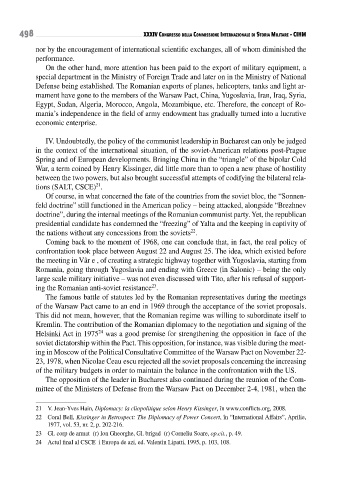Page 498 - Conflitti Militari e Popolazioni Civili - Tomo I
P. 498
498 XXXIV Congresso della CommIssIone InternazIonale dI storIa mIlItare • CIHm
nor by the encouragement of international scientific exchanges, all of whom diminished the
performance.
On the other hand, more attention has been paid to the export of military equipment, a
special department in the Ministry of Foreign Trade and later on in the Ministry of National
Defense being established. The Romanian exports of planes, helicopters, tanks and light ar-
mament have gone to the members of the Warsaw Pact, China, Yugoslavia, Iran, Iraq, Syria,
Egypt, Sudan, Algeria, Morocco, Angola, Mozambique, etc. Therefore, the concept of Ro-
mania’s independence in the field of army endowment has gradually turned into a lucrative
economic enterprise.
IV. Undoubtedly, the policy of the communist leadership in Bucharest can only be judged
in the context of the international situation, of the soviet-American relations post-Prague
Spring and of European developments. Bringing China in the “triangle” of the bipolar Cold
War, a term coined by Henry Kissinger, did little more than to open a new phase of hostility
between the two powers, but also brought successful attempts of codifying the bilateral rela-
tions (SALT, CSCE) .
21
Of course, in what concerned the fate of the countries from the soviet bloc, the “Sonnen-
feld doctrine” still functioned in the American policy – being attacked, alongside “Brezhnev
doctrine”, during the internal meetings of the Romanian communist party. Yet, the republican
presidential candidate has condemned the “freezing” of Yalta and the keeping in captivity of
the nations without any concessions from the soviets .
22
Coming back to the moment of 1968, one can conclude that, in fact, the real policy of
confrontation took place between August 22 and August 25. The idea, which existed before
the meeting in Vârčeč, of creating a strategic highway together with Yugoslavia, starting from
Romania, going through Yugoslavia and ending with Greece (in Salonic) – being the only
large scale military initiative – was not even discussed with Tito, after his refusal of support-
ing the Romanian anti-soviet resistance .
23
The famous battle of statutes led by the Romanian representatives during the meetings
of the Warsaw Pact came to an end in 1969 through the acceptance of the soviet proposals.
This did not mean, however, that the Romanian regime was willing to subordinate itself to
Kremlin. The contribution of the Romanian diplomacy to the negotiation and signing of the
Helsinki Act in 1975 was a good premise for strengthening the opposition in face of the
24
soviet dictatorship within the Pact. This opposition, for instance, was visible during the meet-
ing in Moscow of the Political Consultative Committee of the Warsaw Pact on November 22-
23, 1978, when Nicolae Ceaučescu rejected all the soviet proposals concerning the increasing
of the military budgets in order to maintain the balance in the confrontation with the US.
The opposition of the leader in Bucharest also continued during the reunion of the Com-
mittee of the Ministers of Defense from the Warsaw Pact on December 2-4, 1981, when the
21 V. Jean-Yves Hain, Diplomacy: la cliopolitique selon Henry Kissinger, în www.conflicts.org, 2008.
22 Coral Bell, Kissinger in Retrospect: The Diplomacy of Power Concert, în “International Affairs”, Aprilie,
1977, vol. 53, nr. 2, p. 202-216.
23 Gl. corp de armatč (r) Ion Gheorghe, Gl. brigadč (r) Corneliu Soare, op.cit., p. 49.
24 Actul final al CSCE či Europa de azi, ed. Valentin Lipatti, 1995, p. 103, 108.

